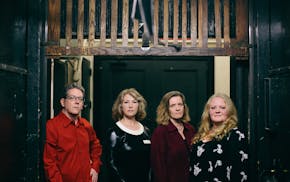Mali Anderson remembers the first time she held her younger son.
The woman who gave birth to Ian laid him in Anderson's arms when he was just a few weeks old. She saw her adopted son's big blue eyes and her breath caught in her throat.
"It was an instant connection," Anderson said. "It was this moment of immense love and gratitude. It was almost surreal."
Moments like that are becoming less common in Minnesota and across the country as the number of domestic and international adoptions plunges.
The sharp decline, specialists in the field say, is the result of fewer unplanned pregnancies, less stigma associated with single motherhood, and changes to laws governing international adoption.
And it's having growing impact: Two Minnesota nonprofit adoption programs, for example, have been forced to merge. Another nonprofit, Catholic Charities, has shut down its adoption services in the Twin Cities and St. Cloud altogether.
In 2014, the most recent year for which data are available, there were an estimated 1,563 adoptions in Minnesota. Less than a decade earlier, there were 2,900 per year.
"Overall, the numbers are down," said Charles Johnson, president and CEO of the National Council for Adoption, a Washington, D.C.-based advocacy group. "Where we have seen the most tremendous decline is with intercountry adoption."
Lutheran Social Service and Children's Home Society of Minnesota merged their adoption services five years ago, citing declines in infant and international adoptions. Now, it handles more foster care adoptions than any other kind.
"Two years ago, we hit a historic milestone where we did more adoptions out of foster care than we did intercountry," said Alexis Oberdorfer, senior director of adoption for Children's Home Society and Lutheran Social Service. "There are plenty of kids in our own backyard who need a home."
In fact, foster care adoptions are the one area seeing growth, climbing nearly 30 percent over the last decade in Minnesota.
It's a dramatic change in a relatively short time.
A decade ago, Children's Home Society alone handled 742 adoptions across four states and most of them were international. In 2017, the combined Children's Home and Lutheran Social Service program handled 275 adoptions: 137 from foster care, 95 international adoptions and 43 domestic infant adoptions.
Stephanie and Robert Townsend of Crystal turned to the agency because they knew they wanted to grow their family through adoption. But a baby didn't seem like a good fit, they said, and spending weeks overseas negotiating an international adoption wasn't feasible with two other children at home. So the Townsends adopted a 15-year-old from the foster care system.
"I believed in my heart I had it in me. My husband felt the same way," Stephanie Townsend said. "We were strong enough to support the needs of a child who has really felt alone."
Adoption declining
At any given time, thousands of families nationwide are pursuing adoptions, said Johnson, noting that the process can take several years.
"We've created a strong culture of adoption in the United States," Johnson said.
In the past, many children adopted by U.S. parents came from foreign countries. But international adoptions, which peaked in 2004 at 23,000 nationwide, have plummeted. In Minnesota, where there once were more than 900 international adoptions per year, there were 160 last year.
Some foreign countries have restricted or banned international adoption of their orphan children in the past decade. Russia, Ethiopia, Nepal and Guatemala have all closed or limited adoptions.
Johnson said most Americans now looking to adopt overseas go to China, but even those adoptions have decreased.
"That is a decision of the Chinese government," Johnson said. "The Chinese government would say they are working more with citizens of other countries and a growing domestic adoption program."
The Hague Convention, an international treaty drafted in the 1990s to improve international adoption and safeguard against child trafficking, has also slowed adoptions as some countries struggle to meet its parameters. Nearly 100 countries have signed on, including the United States, which began enforcing it in 2008.
"The first goal of The Hague Convention is for a child to stay in country. That is good for kids," said Nancy Lyner, development director at Evolve Adoption & Family Services in Stillwater. But it often means international adoptees wait in orphanages longer and endure more trauma. "The bad news is international adoptions are now older and they are a lot like our foster care children."
Within the United States, there are other factors behind the drop in infant adoptions.
The slide started in the 1970s after abortion became legal, Johnson said. "Adoption started taking a back seat to the other options women had," he said.
Domestic infant adoption now hovers around 18,000 a year, with about 300 in Minnesota. The numbers have dropped as the stigma against single mothers and the number of unplanned pregnancies decline. The teen pregnancy rate in the United States is at a record low, according to the National Center for Health Statistics.
Cases of relatives adopting family members, including nieces, nephews and grandchildren have also dipped. Hennepin County Social Worker Lisa Berry said that isn't necessarily bad news.
"Families can make plans on their own without involving child protection services," Berry said. "They are finding other resources."
More open and candid
The adoptions that go forward are often different from those of the past, with more connection to birth families, increased awareness of childhood trauma and a growing support network, especially for foster care adoptions.
"Across all types of adoption, people need to learn about that stuff," said Michelle Chalmers, executive director of Ampersand Families, a small Minnesota adoption agency that deals exclusively with foster care adoptions. "They certainly need to be prepared for those things so they can create a healing home."
Agencies also candidly discuss the responsibilities of raising a child of a different race, said Oberdorfer of Lutheran Social Service and Children's Home Society. It's an issue close to her heart, as an African-American woman raised by white adoptive parents.
"It's really self-inventory for people to do," Oberdorfer said. "What does it take to raise a child of color?"
Nearly all the infant adoptions through Lutheran Social Service and Children's Home Society are open, meaning the birth mother and adoptive parents agree on some form of contact, ranging from occasional letters with photos to phone calls to visits.
"We don't send birth mothers out of state to have a baby and come back and pretend it never happened," Oberdorfer said.
The Andersons, who live in Greenfield, have a relationships with Ian's birth mother and grandparents.
"At first, I was scared," Mali Anderson said. "Would we ever have privacy in our lives?"
But it has worked out better than she ever imagined. Ian's birth mom and birth grandparents come to birthday parties and holidays. Sometimes his birth mother, whom he calls his "tummy mommy," babysits Ian, now 4, and the Andersons' older son, Chase.
"Ian's birth mother and the whole family are just amazing," Anderson said. "I just feel we are so blessed."
Shannon Prather • 612-673-4804

The 5 best things our food writers ate this week

A Minnesota field guide to snow shovels: Which one's best?

Summer Camp Guide: Find your best ones here

Lowertown St. Paul losing another restaurant as Dark Horse announces closing
